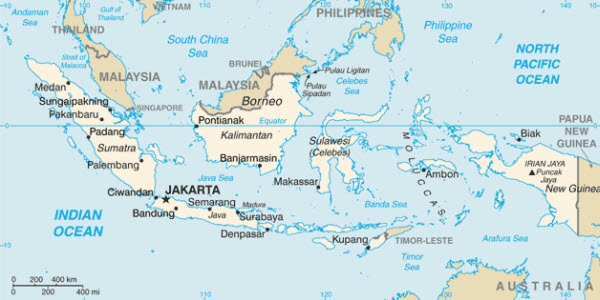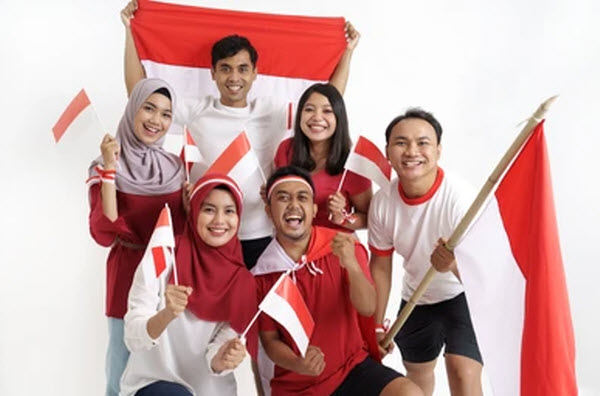Indonesia is an archipelago country located in Southeast Asia and Oceania, consisting of over 17,000 islands. It is one of the largest nations in the world by population and area, and a major regional power in Southeast Asia.
Geography

Location: Southeast Asia, Oceania
Coordinates: Approximately 0.7893° S, 113.9213° E
Area: About 1,904,569 square kilometers, spread across thousands of islands.
Borders:
- North: Malaysia (1,782 kilometers), Papua New Guinea (820 kilometers), Timor-Leste (228 kilometers)
- East: Pacific Ocean
- South: Indian Ocean
- West: Indian Ocean
Climate:
Indonesia has a tropical climate with two distinct seasons: the dry season (May to September) and the rainy season (October to April). Temperatures are generally warm year-round, with variations depending on altitude.
Topography:
Indonesia is characterized by mountainous terrain, including volcanoes, coastal plains, tropical rainforests, and large river systems. The country is part of the Pacific Ring of Fire, with frequent volcanic and seismic activity.
Elevation:
The highest peak is Puncak Jaya on the island of Papua, with an elevation of 4,884 meters.
Natural Resources:
Indonesia is rich in natural resources such as oil, natural gas, coal, tin, copper, gold, and fertile land for agriculture.
Land Use:
- 31% agriculture
- 49% forests
- 20% urbanized and other uses
Population Distribution:
Population density is highest on the island of Java, which is home to more than half of the country’s population, while outer islands are less densely populated.
Population and Society

Population: Approximately 277 million (2024 estimate).
Ethnic Groups:
Indonesia is home to hundreds of ethnic groups, with Javanese (40%) and Sundanese (15%) being the largest. Other groups include Madurese, Minangkabau, Bugis, and many more indigenous peoples.
Languages:
The official language is Bahasa Indonesia. Many regional languages such as Javanese, Sundanese, and Balinese are widely spoken.
Religions:
Indonesia is the world’s largest Muslim-majority country, with around 87% of the population identifying as Muslim. There are also Christian (10%), Hindu, and Buddhist minorities.
Age Structure:
Indonesia has a relatively young population, with a median age of around 30 years. The population is growing, but the rate has been gradually slowing.
Population Growth Rate:
Approximately 1.1% annually.
Country

Country Name: Republic of Indonesia
Common Name: Indonesia
Reason for Name: Derived from the Latin word “Indus” meaning India, and the Greek word “nesos” meaning islands, reflecting its geographic location and archipelagic nature.
Type of Government: Unitary Presidential Constitutional Republic.
Capital: Jakarta (planned relocation to Nusantara on Borneo island).
Reason for Naming Capital: Jakarta’s historical significance as a major city and trade hub.
Local Time: Indonesia spans three time zones: Western Indonesia Time (WIB), Central Indonesia Time (WITA), and Eastern Indonesia Time (WIT).
Daylight Saving Time: Not observed.
Administrative Divisions: Indonesia is divided into 38 provinces, each with varying degrees of autonomy.
Territories: Indonesia does not have overseas territories, but it consists of several island groups including Sumatra, Java, Kalimantan (Borneo), Sulawesi, Papua, and the Lesser Sunda Islands.
Independence: Gained independence from the Netherlands on August 17, 1945.
Citizenship Acquisition: Through birth in Indonesia, descent from Indonesian parents, or naturalization.
Legal System: Civil law system based on the Constitution of 1945 and subsequent legal codes.
Executive Branch: The president is the head of state and government.
Legislative Branch: The People’s Consultative Assembly, consisting of the Regional Representative Council and the People’s Representative Council.
Judicial Branch: Includes the Supreme Court of Indonesia and the Constitutional Court.
Political Parties: Major political parties include the Indonesian Democratic Party of Struggle (PDI-P), the Great Indonesia Movement Party (Gerindra), Golkar Party, and the National Awakening Party (PKB).
Flag Description: The Indonesian flag consists of two horizontal stripes: red on the top and white on the bottom, symbolizing courage and purity.
Country Code: IDN
Economy
GDP: Approximately $1.4 trillion USD.
Agricultural and Animal Products: Rice, palm oil, coffee, tea, spices, livestock, and fish.
Industries: Key industries include oil and gas, coal, textiles, palm oil, electronics, and automotive.
Budget: Indonesia maintains a balanced budget with focus on development projects and infrastructure.
Exports: Palm oil, coal, textiles, rubber, coffee, and oil.
Imports: Machinery, chemicals, fuel, food products, and consumer goods.
Foreign Reserves: Approximately $130 billion USD.
External Debt: About $410 billion USD.
Local Currency: Indonesian Rupiah (IDR).
Communications
Landlines: About 11 million lines.
Mobile Lines: Approximately 370 million lines.
Country Code: +62
Broadcast Media: Indonesia has a large variety of national and regional television and radio channels, including public and private broadcasters.
Internet Code: .id
Internet Users: Around 212 million people.
Transportation

National Air Transport System: Indonesia has an extensive air transport system, with international airports in Jakarta, Bali, Surabaya, and other major cities.
Airports: Around 676 airports across the country, including several major hubs.
Helipads: Common in metropolitan areas and industrial regions.
Pipelines: Extensive pipelines for transporting oil and natural gas.
Railroads: Indonesia has a developing rail network, primarily on the islands of Java and Sumatra.
Road Network: More than 500,000 kilometers of roads, including toll highways connecting major cities.
Ports: Major ports include Tanjung Priok (Jakarta), Tanjung Perak (Surabaya), and Belawan (Medan).
Military

Military Composition: The Indonesian National Armed Forces (TNI) include the Army, Navy (with Marine Corps), and Air Force.
Military Spending: Approximately $8 billion USD annually.
Military and Security Personnel: Around 400,000 active-duty personnel.
Military Equipment: Includes fighter jets, naval vessels, submarines, and armored vehicles.
Military Service Age: Military service is voluntary, with recruits starting at 18 years of age.
